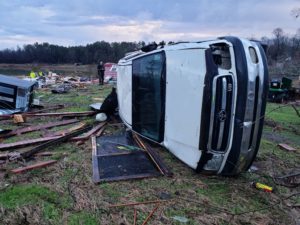Exxon Lied About Oil Pipeline Rupture, Documents Show
According to newly released documents, Exxon Mobil--the world's most profitable corporation--knew that contamination from a tar sands crude oil spill in Arkansas this year was dangerous and yet, the company downplayed it anyway.
According to newly released documents, Exxon Mobil–the world’s most profitable corporation–knew that contamination from an oil spill in Arkansas this year was dangerous and yet, the company downplayed it anyway. At least 210,000 gallons of tar sands crude oil emanated from the Pegasus pipeline when it burst in late March, flooding residences in Mayflower with the thick, tarry substance and running into nearby Lake Conway.
Documents gathered by the environmental organization Greenpeace reveal that the company tried to pass the area off as “oil-free” in the draft of a press release in early April, even as internal emails show Exxon knew about significant amounts of contamination in Lake Conway that had resulted from the spill. Greenpeace recently obtained the new batch of documents through a Freedom of Information Act request to the state’s Department of Environmental Quality.
More than 100,000 gallons of tar sands crude oil remain unaccounted for, according to Exxon data.
AlterNet:
Records of emails between Arkansas’ DEQ and Exxon depict attempts by Exxon to pass off press releases with factually false information. In a draft press release dated April 8, Exxon claims “Tests on water samples show Lake Conway and the cove are oil-free.” However, internal emails from April 6 show Exxon knew of significant contamination across Lake Conway and the cove resulting from the oil spill.
When the chief of Arkansas Hazardous Waste division called Exxon out on this falsehood, Exxon amended the press release. However, they did not amend it to say that oil was in Lake Conway and contaminant levels in the lake were rising to dangerous levels, as they knew to be the case. Instead, they continue to claim that Lake Conway is “oil-free.” For the record, Exxon maintains that the “cove,” a section of Lake Conway that experienced heavy oiling from the spill, is not part of the actual lake. Exxon maintains this distinction in spite of Arkansas Attorney General Dustin McDaniel saying unequivocally “The cove is part of Lake Conway…The water is all part of one body of water.” Furthermore, Exxon water tests confirmed that levels of Benzene and other contaminants rose throughout the lake, not just in the cove area.
Though Exxon was eventually forced to redact their claim that the cove specifically was “oil-free,” the oil and gas giant has yet to publicly address the dangerous levels of Benzene and other contaminants their own tests have found in the body of Lake Conway. The Environmental Protection Agency and the American Petroleum Institute don’t agree on everything, but they do agree that the only safe level of Benzene, a cancer causing chemical found in oil, is zero. Benzene is added to tar sands oil to make it less viscous and flow more easily through pipelines. Local people have reported fish kills, chemical smells, nausea and headaches. Independent water tests have found a host of contaminants present in the lake.
— Posted by Tracy Bloom.
Your support matters…Independent journalism is under threat and overshadowed by heavily funded mainstream media.
You can help level the playing field. Become a member.
Your tax-deductible contribution keeps us digging beneath the headlines to give you thought-provoking, investigative reporting and analysis that unearths what's really happening- without compromise.
Give today to support our courageous, independent journalists.







You need to be a supporter to comment.
There are currently no responses to this article.
Be the first to respond.